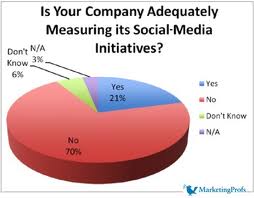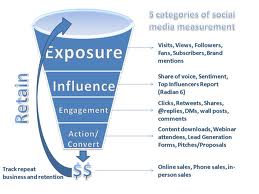 At the end of Tuesday’s post titled “Are non-profits yelling at their donors using social media?” I promised that I’d share a few revelations from a social media conference that Marissa and I attended last week hosted by SkillPath Seminars. Yesterday, I posted “Answers to the two most popular social media questions asked by non-profits,” and today we’re talking about that thing that for-profit companies are obsessed with and non-profits seem to struggle with . . . RETURN ON INVESTMENT (ROI).
At the end of Tuesday’s post titled “Are non-profits yelling at their donors using social media?” I promised that I’d share a few revelations from a social media conference that Marissa and I attended last week hosted by SkillPath Seminars. Yesterday, I posted “Answers to the two most popular social media questions asked by non-profits,” and today we’re talking about that thing that for-profit companies are obsessed with and non-profits seem to struggle with . . . RETURN ON INVESTMENT (ROI).
“43% of current social media marketers haven’t measured ROI.”
This number was shared with Marissa and me by our lovely SkillPath Seminars trainers at last week’s social media conference. They cited this information from King Fish Media in 2010.
Well, if I were a betting man, I would guess that this number is much, much higher when you just look at non-profit organizations using social media.
Let’s be honest. Most non-profit organizations are stretched too thin. So, asking employees to track a lot of stuff as it relates to your social media presence just doesn’t make a lot of sense. Right? However, it is important to measure something. Right? After all, resources are tight and you are dedicating time and resources to this thing called social media. If the ROI is very poor, then you probably have 101 ways to better spend those hours and dollars.
Additionally, keeping an eye on certain metrics also helps you evolve your social media presence and approach because when you see that something isn’t working then you stop and when you see something is working you do more of it.
This brings us to the big question . . . “What can non-profits easily measure and how should they do it?”
 Looking across the fence at our for-profit cousins, I can tell you that they start by asking “What is most important to the success of the company?” It usually boils down into one of four things: conversion rates, generating sales leads, increased site traffic/number of new customers, and brand awareness.
Looking across the fence at our for-profit cousins, I can tell you that they start by asking “What is most important to the success of the company?” It usually boils down into one of four things: conversion rates, generating sales leads, increased site traffic/number of new customers, and brand awareness.
Once they narrow their focus, they then pay a visit to their social media analytics buffet and look around at all of the yummy things that you can track including:
- web traffic
- viral video activity
- bounce rate
- page views
- comments
- social bookmarks
- inbound links to your website
- ratings
- number of new followers
- comments / mentions
- leads generated
- downloads
- uploads
- engagement activity
As we discussed in yesterday’s post — “Answers to the two most popular social media questions asked by non-profits“– your organization probably uses different social media platforms to achieve different objectives in your resource development plan (e.g. Facebook = stewardship; Twitter = cultivation; etc). So, it makes sense that what you measure might look a little different for each of the platforms your agency uses.
 If I were using Facebook to steward donors and didn’t have enough time or money, then I would simply track: 1) how many Friends does my Facebook page have (and how did that number change in the last year), 2) how many “likes” and comments did my posted content generate, and 3) how many Facebook friends remained a donor to my agency in the last year (e.g. donor database loyalty report cross referenced to Facebook Friends list)?
If I were using Facebook to steward donors and didn’t have enough time or money, then I would simply track: 1) how many Friends does my Facebook page have (and how did that number change in the last year), 2) how many “likes” and comments did my posted content generate, and 3) how many Facebook friends remained a donor to my agency in the last year (e.g. donor database loyalty report cross referenced to Facebook Friends list)?
If I were using Twitter to introduce and cultivate new prospective donors, then I would track: 1) how many Followers does my Twitter account have (and how did that number change in the last year), 2) what is my Klout score and level of online influence with my Twitter followers, and 3) how much traffic back to the agency’s website comes from Twitter (e.g. Google analytics from your website will tell you this number and much more).
As I’ve just done in the last two paragraphs, I suggest you do the same for each of your social media platforms: 1) determine your target audience and main objective for each platform and 2) select a small handful of metrics from your analytics program (e.g. Facebook Insights, Google analytics, etc) that make the most sense for what you’re trying to accomplish.
But wait . . . there’s more!
Measuring data for the sake of measuring data is a waste of time. You need to turn your data into something “actionable“. Here are just a few thoughts:
- include it an annual performance plan for the employee who is responsible for managing your social media communities
- build a social media dashboard and share with your marketing or resource development committee every month
- place it on committee meeting and staff meeting agendas and facilitate conversations around the questions: “What does the data tell you?” and “What should we do differently with our content?”
Here are a few links that you might also want to read on this subject from me, Marissa or others:
- Some Insight on Facebook Pages Insights
- How much Klout does your nonprofit have?
- Five Simple Ways Nonprofits Can Measure Social Media ROI (Return on Investment)
Keep it simple. Don’t go overboard. And whatever you do, make sure you use the data.
Does your agency use social media? Are you measuring stuff? What are you measuring? Why are you measuring it? What are you doing with it? Has it made a difference in anything you do online or offline? Please scroll down and share answers to these questions or whatever else is on your mind in the comment box. We can all learn from each other.
Here’s to your health!
Erik Anderson
Founder & President, The Healthy Non-Profit LLC
www.thehealthynonprofit.com
erik@thehealthynonprofit.com
http://twitter.com/#!/eanderson847
http://www.facebook.com/eanderson847
http://www.linkedin.com/in/erikanderson847
